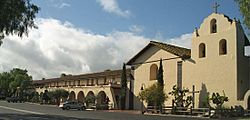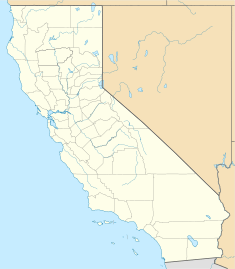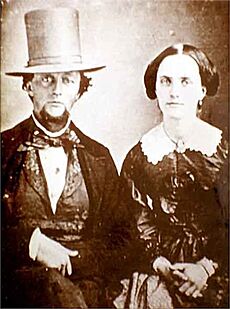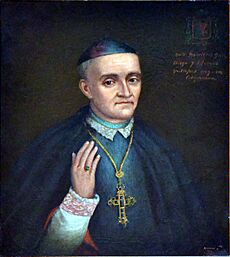Mission Santa Inés facts for kids

Mission Santa Inés in 2005
|
|
| Location | 1760 Mission Drive, Solvang, California 93464 |
|---|---|
| Coordinates | 34°35′40″N 120°8′13″W / 34.59444°N 120.13694°W |
| Name as founded | La Misión de Nuestra Santa Inés, Virgen y Mártir |
| English translation | The Mission of Saint Agnes of Rome, Virgin and Martyr |
| Patron | Saint Agnes of Rome |
| Nickname(s) | "Hidden Gem of the Missions" |
| Founding date | September 17, 1804 |
| Founding priest(s) | Father Presidente Pedro Estévan Tápis |
| Founding Order | Nineteenth |
| Military district | Second |
| Native tribe(s) Spanish name(s) |
Chumash Inéseño |
| Native place name(s) | 'Alahulapu |
| Baptisms | 1,348 |
| Marriages | 400 |
| Burials | 1,227 |
| Secularized | 1836 |
| Returned to the Church | 1862 |
| Governing body | Roman Catholic Archdiocese of Los Angeles |
| Current use | Parish Church / Museum |
| Reference no. | 99000630 |
| Designated | 1999 |
| Reference no. |
|
Mission Santa Inés (also called Santa Ynez) is a historic Spanish mission located in Solvang, California. It was named after Saint Agnes of Rome. Father Estévan Tapís of the Franciscan order founded the mission on September 17, 1804.
The mission was built as a stopping point between Mission Santa Barbara and Mission La Purísima Concepción. It helped ease crowding at those missions. It also served the Chumash people living north of the Coast Range. Sunset magazine once called it the "Hidden Gem of the Missions." They noted its simple, classic mission look.
Mission Santa Inés was home to the first learning center in Alta California. Today, it is a museum and a parish church for the Archdiocese of Los Angeles. It is also a National Historic Landmark. It is known as one of the best-preserved of California's 21 missions.
Contents
Mission Santa Inés: A Look at Its Past
A big earthquake hit near Santa Barbara on December 21, 1812. It badly damaged or destroyed parts of several California missions. Most of the original church at Santa Inés was destroyed. Other mission buildings were also damaged. However, the mission was not abandoned.
Workers built a new church with very thick walls and large pine beams. These beams came from nearby Figueroa Mountain. The new church was officially opened on July 4, 1817. In 1819, a water-powered grist mill was built. It was about half a mile from the church. A grist mill grinds grain into flour.
In 1821, a fulling mill was added. This mill was designed by an American immigrant named Joseph John Chapman. He also helped build a grist mill for Mission San Gabriel. Chapman prepared wood for the first church in Los Angeles. The mill he built near San Gabriel is now a museum.
The Chumash Revolt of 1824
On February 21, 1824, a conflict arose between a soldier and a young Chumash native. This event, along with growing tensions, led to a major uprising. The Chumash revolt of 1824 involved Chumash people from several missions. When the fighting ended, the natives themselves put out a fire that had started at the mission. Many Chumash left to join other tribes in the mountains. Only a few remained at Mission Santa Inés.
Changes After Secularization
In 1833, the missions in California began a process called secularization. This meant the Mexican government took control of the missions. Mission Santa Inés became secularized in 1835. During secularization, government-appointed managers replaced the padres. The Spanish Franciscans were replaced by Mexican Franciscans. These new padres focused only on the spiritual needs of the Chumash.
Under this new system, many Chumash people left the mission. They returned to their villages or worked on settlers' ranches. As a result, much of the mission land was given to settlers.
In 1843, California's Mexican governor, Micheltorena, gave a large area of Santa Ynez Valley land to the College of Our Lady of Refuge. This was the first seminary in California. A seminary is a school for training priests. Francisco García Diego y Moreno, the first bishop of California, started this college at the mission. The college closed in 1881. By then, the mission buildings were falling apart.
Restoring the Mission
The Danish town of Solvang grew up around the mission in the early 1900s. Father Alexander Buckler began efforts to rebuild the mission in 1904. However, major restoration work did not happen until 1947. The Hearst Foundation donated money for this project. Today, the Capuchin Franciscan Fathers continue the restoration work.
Life for Indigenous People at the Mission
The Alta California mission system was created by Catholic priests of the Franciscan order. Their goal was to teach Native Americans about Christianity. The missionaries brought new European fruits, vegetables, cattle, and horses. They also introduced new farming and ranching methods.
The native people at Santa Inés worked as laborers. The mission's farming changed the local environment a lot. New plants like peas, squash, potatoes, olives, grapes, and peaches were introduced. European plants and weeds quickly spread along California's coast.
Many Native Americans in missions faced new diseases from Europe and Asia. They had no natural protection against these illnesses. Studies show that at the Santa Barbara Channel Missions, including Santa Inés, living conditions played a big role in population decline. Crowded living spaces helped diseases spread easily. These conditions were part of the mission's plan to change the Native Americans' culture and religion.
Keeping Mission Santa Inés Alive Today
Mission Santa Inés is one of California's oldest buildings. It needs constant care and repair to stay standing. Many people have worked hard over the years to preserve this important historical site.
Past efforts have included restoring buildings made of adobe (dried mud). Adobe structures are easily damaged by weather, ground shifts, and earthquakes. Without proper care, the mission's walls can crack, and its artwork can fade.
The local church members are mostly responsible for restoring Mission Santa Inés. However, others have also helped. The mission does not get money from the state or federal government. Instead, it relies on museum entrance fees, fundraisers, and donations from people and foundations. Groups like the California Mission Foundation have also given important grants for restoration.
Images for kids
See also









